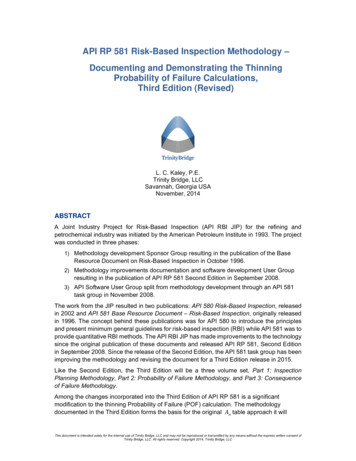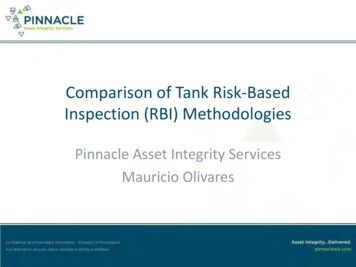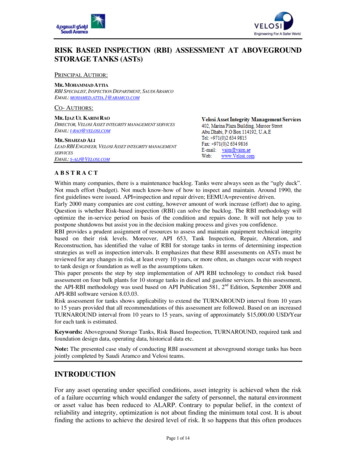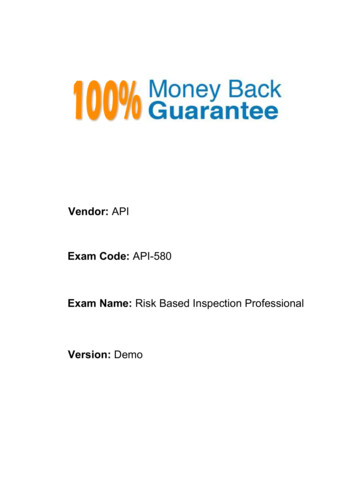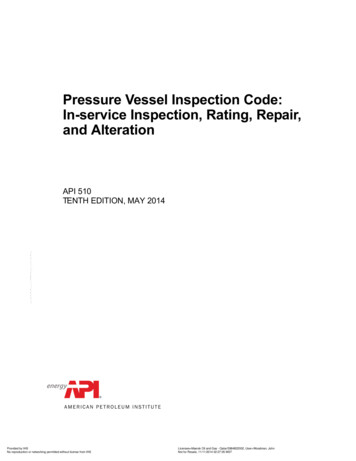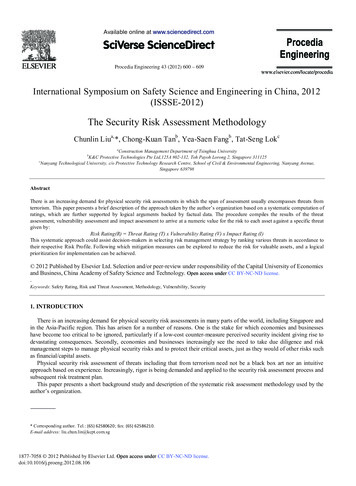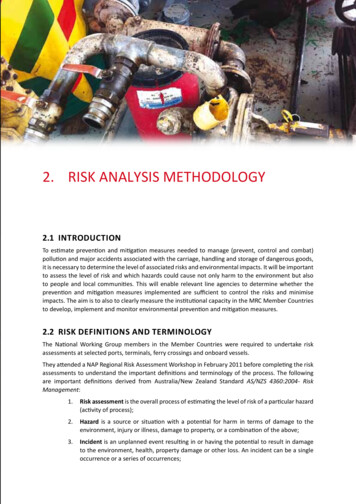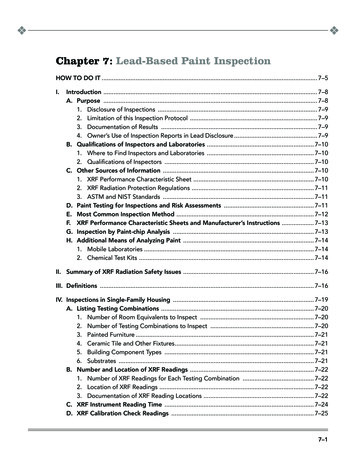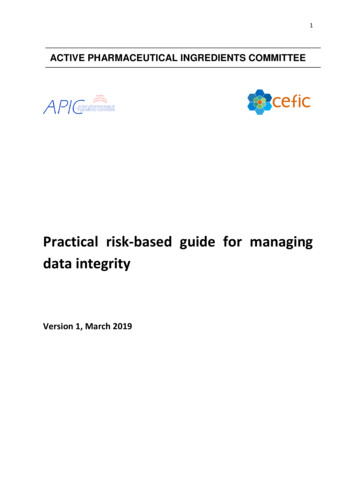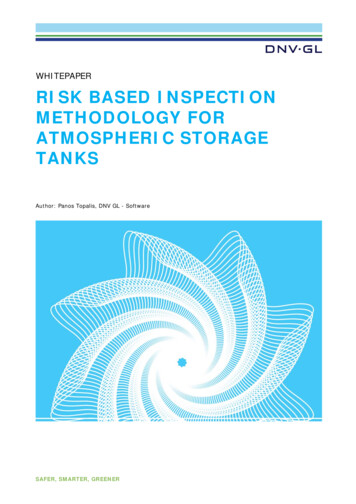
Transcription
WHITEPAPERRISK BASED INSPECTIONMETHODOLOGY FORATMOSPHERIC STORAGETANKS Author: Panos Topalis, DNV GL - SoftwareSAFER, SMARTER, GREENER
Reference to part of this report which may lead to misinterpretation is not permissible.No.DateReason for Issue12014-02First issue22017-09Revision and re-brandingDate: September 2017Branded by DNV GL - Software DNV GL AS. All rights reservedThis publication or parts thereof may not be reproduced or transmitted in any form or by any means,including copying or recording, without the prior written consent of DNV GL AS. Risk based inspection whitepaper Synergi Plant - RBI www.dnvgl.com/software
INTRODUCTIONAtmospheric Storage Tanks (ASTs) are significant and common equipment items in the oil, chemical andtransportation industry. Figure 1 shows two common types of tanks, one with a fixed roof and anotherwith a floating roof. ASTs are often used to store very large amounts of inventory, mostly flammableliquids and sometimes toxic liquids. Their content might be kept under atmospheric temperature andpressure but can also sometimes be refrigerated. The hazards from ASTs can be serious given the largeamounts of liquid. ASTs can cause serious environmental problems should a liquid leak reach surface orunderground waters. Another difficulty with floor leaks is that they go undetected for a long time and cancause serious contamination of the soil or sub-surface water. Rapid floor failure or catastrophic shellfailure are rare events but they do occur and they can have very serious consequences. Clean-up of theground, the groundwater and the surface water are very costly operations that tank owners wouldobviously wish to avoid.API 653 [13] is the standard code for inspection, repair, alteration and reconstruction of ASTs. It shouldbe noted that internal examination of the tank, especially of the floor, is difficult and costly. So it isimportant for operators to identify the tanks that do not require frequent internal inspection and repairand avoid the wastage of maintenance and inspection resources, instead using their resources where itmatters: that is when the risk is high and the inspections are useful. This has led tank operators to lookfor a risk based inspection (RBI) methodology applicable to aboveground storage tanks. EEMUA 159 [16]is a well-known guidance (particularly in Europe) for inspection, maintenance and repair of ASTs and itfully endorses RBI techniques. Risk based inspection whitepaper Synergi Plant - RBI www.dnvgl.com/software
Figure 1: Aboveground storage tanks of fixed roof and floating roof respectively.It is worth summarizing the reasons that motivated the development of the AST RBI methodology: Environmental concerns have increased. There is a large number of tanks with leaking floors andthe fear exists of the rare but serious event of tank catastrophic rupture. Costs for environmentalclean-up and penalties are increasing. Internal inspection of the tanks is costly and difficult. Access to floors is difficult and shellinspection requires complex scaffolding and preparation. Backlog of tank inspections. Many tanks are overdue for inspection. Inconsistency in regulatory requirements. Inspection intervals vary from country to country andthey are even different among US states (inspection intervals varying from 8 to 20 years). Prioritization of tank inspections has been largely subjective before the adoption of RBI.Risk Based InspectionThe risk based inspection (RBI) approach had already been well established and widely used in the oil &gas, refining, petrochemical and chemical industries. The essential elements of a “quality” risk basedinspection analysis have been documented by the American Petroleum Institute (API) in API RP 580(2016)[1]. API RP 581 (2016) [2] describes a specific RBI methodology with full details: data tables,algorithms, equations and models. The implementation of the RBI methodologies has been facilitated bycommercial software tools such as Synergi Plant RBI Onshore (Topalis, 2007) [3], SYNERGI Plant RBIOffshore (Topalis et al, 2011) [4], API RBI (Panzarella et al, 2009) [5], RISKWISE (Ablitt and Speck,2005) [6] and others. The RBI benefits are well known (API RP 580, 2016) [1] and they can besummarized as follows: Risk ranking and prioritization of inspection and maintenance activities Optimize spending on maintenance and inspection RBI may significantly alter the inspection strategies to become more “efficient” RBI may provide substantial cost savings RBI may contribute to reducing operational risks or improved understanding of current risks Improved communication between operations, inspection and maintenance2 Risk based inspection whitepaper Synergi Plant - RBI www.dnvgl.com/software
RBI study provides a database for easy future inspection scheduling, updating and risk control RBI improves the mechanical integrity system and provides the means to measure theeffectiveness of inspectionHowever, it should be said that any RBI methodology relies on the quality of the input data, theassumptions made, and so on.Synergi Plant RBI AST implements DNV GL’s methodology for risk based inspection of abovegroundstorage tanks. The origin of the methodology is the AST Risk Assessment Manual RAM (API, 2002) [8]initially created for the AST committee of API and later encouraged by the RBI committee of API. Theinitial scope was mainly tank floor thinning. The methodology was later extended to include aquantitative method for shell thinning, as well as susceptibility analysis (supplement analysis) for shellbrittle fracture and cracking.Figure 2 shows a typical process plant hierarchy and the AST data structure and position in this hierarchy.The tank is part of a process unit involving several more tanks, while the tanks are sub-divided into Floorand Shell. This distinction is because of different failure scenarios for the Floor and the Shell. The Shell isfurther sub-divided into Courses. Each course may have a different thickness and Point of Failure (PoF).Figure 2: Asset Hierarchy for RBI of Atmospheric Storage TanksFigure 3 shows how risk is calculated for an equipment item in a quantitative RBI analysis, such as theapproach in Synergi Plant RBI AST. This is the product of the probability of failure (PoF) and theconsequence of failure (CoF). CoF can be expressed in terms of the environmental/safety consequenceeffects and the economic effects. On the other hand, PoF is the product of the Generic Failure Frequency(GFF), statistical frequency of failure for a given type of tank, based on API members’ survey (API, 1994)[9] and other sources, and the damage factor (DF).3 Risk based inspection whitepaper Synergi Plant - RBI www.dnvgl.com/software
Components in the calculation of the riskModified Failure Frequency RiskMFWhere:DF - is the DamageFactorGFF - is the genericfailure frequencyMF - is a managementfactorxGFFxXConsequence of FailureItem DFAgeDamage areaDamage type/rateOther repairsItem repairInjuryBusiness int.InspectionHistoryFigure 3: Calculation of Risk for an equipment itemRisk / DFDamage Factor (DF)AcceptableRisk LevelFairly EffectiveHighly EffectivePredicted RiskIncreaseTime to nextinspectionLast inspection dateNow1st TurnaroundInspectionMaximum FutureInspection Eval.IntervalDateTimeFigure 4: Evergreening: How RBI automatically proposes inspection dates/effectivenessFigure 4 illustrates the process of determining the next inspection date and the inspection effectiveness.A maximum acceptable risk level is set by the user. A future evaluation date is then selected by the userand the risk is calculated as a function of time. If the risk at the future evaluation date exceeds themaximum acceptable level, an inspection is suggested. The intersection of the risk curve and themaximum acceptable line sets the next inspection date. The inspection may need to be included in thenext turnaround, if it cannot be done on-stream. The inspection effectiveness is selected so that, afterinspection, the risk does not exceed the maximum acceptable level at the future evaluation date.The reader is also referred to the API codes for ASTs (API 650) [10] and inspection codes (API 651, API652, API 653, API 12D and API RP 575 [11]-[15].4 Risk based inspection whitepaper Synergi Plant - RBI www.dnvgl.com/software
AST RBI Scenarios, PoF and CoF Models and Inspection PlanningTable 1 shows the liquid release scenarios typically considered in an AST RBI methodology according tothe API 581 methodology. These include: One floor leak scenario and one floor catastrophic floor rupture (floor to shell region) Three shell leak scenarios and one shell catastrophic rupture Roof gas leak scenario according to EEMUA 159Figure 5 shows the six modelled consequence outcomes in order of increasing severity: Release inside the dyke Release inside the plant fence but outside the dyke Release offsite Sub-surface soil contamination Groundwater contamination Surface water contaminationFigure 6 shows the overall methodology for calculating corrosion rates, PoF, CoF, Risk and Inspectionplanning for the floor and shell: Corrosion rates are estimated first, on the product side, soil side and external corrosion Damage factor DF and PoF are then calculated CoF is then calculated depending on the scenarios and this is followed by risk calculation The inspection planning is decided based on the planning targets for DF, Risk or PoFThe RBI methodology calculates the total cost (CoF) as the sum of the environmental cost, equipmentdamage cost, outage cost and safety cost:CoF Total Cost Environmental Cost Equipment Repair Cost Outage Cost Safety CostEquipment damage and safety cost only apply to Shell releases, while floor releases are assumed not tocause safety costs.5 Risk based inspection whitepaper Synergi Plant - RBI www.dnvgl.com/software
Table 1: Release scenarios analysed in the AST RBI methodologyRelease Failure ScenariosSmall bottom leak.CommentOne hole size is considered: small leak (0.125" diameterhole).Leak may persist for anextended period, depending onlocal leak monitoring.Rapid bottom failure.This is the main floor failure scenario that is addressed inthe RBI methodology, and is focused on bottom corrosion.The Probability can be influenced by inspection.One scenario, catastrophic failure.Instantaneous release of tankcontents from failure at thecritical zone (Floor-to-Shellregion).Small Shell leak.Addressed in the RBI methodology through the corrosionmodel and compliance with recognized design andinspection/maintenance codes. The Probability is only to alimited degree influenced by inspection.Three hole size scenarios: 0.125", 0.5" and 2" diameterhole.Leak detected visually or bymonitoring.This is the main Shell failure scenario that is addressed inthe RBI methodology, and is focused on Shell corrosion.The Probability can be influenced by inspection.One scenario, catastrophic failure.Rapid Shell failure.Instantaneous release of tankcontents from brittle fractureor large rupture of the tankShell.Roof leakAddressed in the RBI methodology by screening, and is notinfluenced by inspection for corrosion.Scenario modelled semi-quantitatively according to EEMUA159AST Consequence AnalysisOverview of scenariosdyke / RPB/catch basin12surface water3onsite6offsiteSub-surface soil45ground waterFigure 5: Environmental and economic scenarios6 Risk based inspection whitepaper Synergi Plant - RBI www.dnvgl.com/software
STARTDetermine Corrosion Rate: Soil side CR – Calculatedo Base CRo Adjustment factors Soil resistivity Tank padquality CP, etc. Product side CR – Calculatedo Base CRo Adjustment factors Coating Water draw,etc. External CR – Calculatedo Base CRo Adjustment factors Climate Coating, etc. Measured CR – Inspection Use Calc., Measured or ExpertConsequence Calculations: Clean-up cost Fluid Type Distance to groundwater Estimated time to detect a leak Soil type, etc.Risk Calculation PoF CoFo Flooro Shell Risk Exposure ( /Yr)DF and PoF Calculation CR, Age, Nominal WT Past Inspections DF ‘ar/t’ Modif. Factor Generic Failure Frequency Condition factorso Liner,o Maintained to API653o Settlement Probability of Failure (PoF)Inspection PlanningCriteria for Inspection Target Damage Factor Risk target PoF target Recommended inspection time for Floor and ShellFigure 6: Overview of the floor and shell RBI methodology7 Risk based inspection whitepaper Synergi Plant - RBI www.dnvgl.com/software
ResultsThe AST RBI methodology produces risk results for a set of tanks (floor & shell risk matrices, executivesummaries) but it also produces a detailed risk profile and inspection plan for each tank (equipmentsummary sheet). This can answer questions about what, when and how to inspect (what technique/effectiveness & coverage). This is shown in Figure 7.If one or more risk targets are set, the inspection time will be determined by the intersection betweenthe risk curve (function of time) and the “target” line. Figure 8 shows a real case study where the RBIsuggested date is later than the old regulation inspection date and the date determined by API 653. Butthis is not always the case and RBI can sometimes suggest an earlier date depending on the tank risk.Figure 7: Risk Matrix, Executive summary and AST summary reports8 Risk based inspection whitepaper Synergi Plant - RBI www.dnvgl.com/software
Figure 8: Real case with RBI suggested date against the old regulation inspection date andthe date determined by API 653CONCLUSIONA risk-based inspection (RBI) methodology for aboveground storage tanks has been presented in thispaper. The objective of this work is to allow management of the inspections of atmospheric storagetanks in the most efficient way, while at the same time minimizing accident risks. This RBI methodologyis an evolution of an approach and mathematical models developed for DNV GL, the American PetroleumInstitu
the API 581 methodology. These include: One floor leak scenario and one floor catastrophic floor rupture (floor to shell region) Three shell leak scenarios and one shell catastrophic rupture Roof gas leak scenario according to EEMUA 159 Figure 5 shows the six modelled consequence outcomes in order of increasing severity: Release inside the dyke Release inside the plant fence but outside the .
